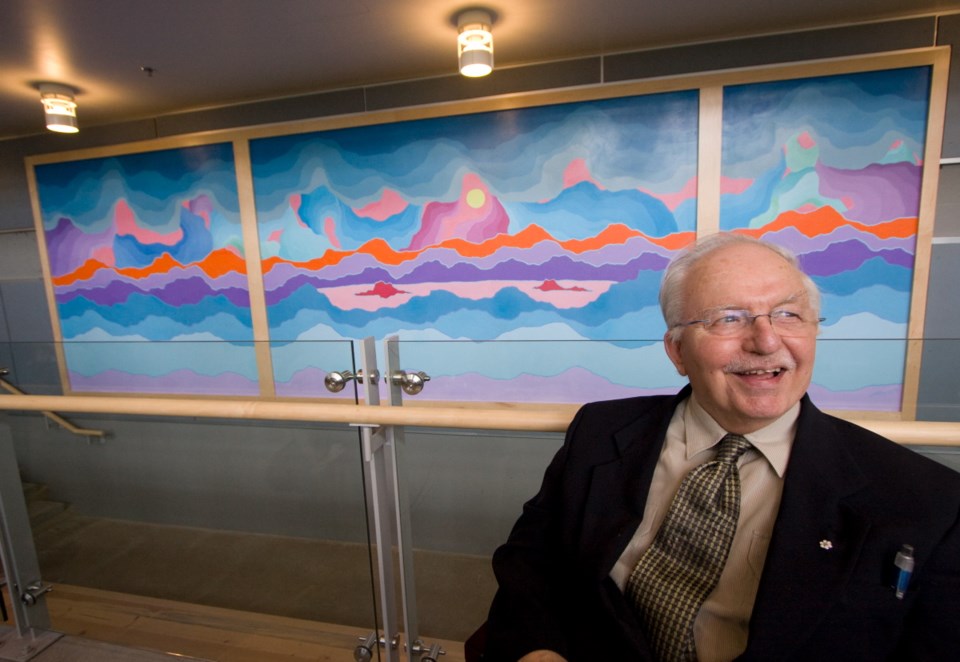His artwork was instantly identifiable, unmistakably Canadian and hugely successful at depicting the Far North as a friendly and brilliantly coloured place.
Artist Ted Harrison, reknowned for his vivid and whimsical depictions of the Yukon and the B.C. coast, died Friday in Victoria at 88.
Harrison, who had lived here since 1993, had been in failing health for at least a year, friends said.
“It wasn’t a surprise, but it’s always a surprise,” said Comox author Katherine Gibson, who spent four years writing a book about Harrison called Painting Paradise.
“He was Canada’s most beloved artist,” Gibson said, but his work was never accepted by the National Gallery of Canada, something she views as unfair given how eloquently his paintings have spoken about life in the North.
“He showed us the joy of the North,” she said, something seldom depicted before. When Laureen Harper invited Harrison and Gibson to 24 Sussex Drive they overstayed tea-time because the prime minister’s wife was so “enthralled,” she recalled. His fame seemed to really sink in with him then, said Gibson, who felt a daughterly relationship with him.
In 2012, Painter’s Lodge in Campbell River presented a special salute to “Canada’s most popular artist” and screened a Monty Bassett documentary on Harrison’s life called The Land of the Chartreuse Moose, based on Gibson’s book.
“He lived a fascinating life,” said University of Victoria archivist Lara Wilson, grateful that the David Turpin Building, which is open to the public, displays two large murals Harrison donated. UVic also has several boxes of archival material, including Harrison’s sketchbook, paint tubes and painting apron.
Born in 1926 to a coal miner and his wife in Wingate, northeast England, Harrison was lucky his parents recognized his talent and sent him to art school. After serving in the Second World War, he taught art in Malaysia and New Zealand. Then he spotted a newspaper ad for a teacher needed in Canada. Off he went to Wabasca, a Cree area in northern Alberta, with his wife, Robina, and son Charles. It was 1967. Soon after, they headed to the Yukon, where the Whitehorse area was home for a quarter century.
While there, he imposed the tropical colours he had absorbed from the South Seas onto the grey and white northern landscapes, said Times Colonist art critic Robert Amos. In doing so, he remade the image of the vast North for southern Canada and struck a bond with children. “Every schoolchild in this country knows exactly who Ted Harrison is,” Amos said.
Along the way, Harrison designed the Yukon Pavilion for Vancouver’s Expo 86 and earned the Order of Canada in 1987.
In 1993, his wife’s poor health brought him to Victoria, where he operated The Ted Harrison Gallery on Oak Bay Avenue for several years.
Esquimalt restaurateur Ken Yu, another former Yukoner, became friends with Harrison, who was a regular at his Vietnam Garden. Yu ultimately named his only son, Ted, now 8, in Harrison’s honour and took art lessons from him.
“We loved Ted Harrison,” said Yu, who recently took some wonton soup to the artist’s home. Yu is thankful for the advice Harrison gave him about “how to do business so that people love you.”
Amos recalled Harrison as “extremely charming,” able to tell tales like no one else and happy to take part in the Moss Street Paint-In or visit schools when he was able. He became an ardent spokesman for the fight against Alzheimer’s disease, which affected his wife, who died in 2000.
“It’s a time to celebrate what a tremendous contribution he’s made to our community in so many ways,” Amos said, predicting Harrison’s work will eventually hang in the National Gallery. “We have by no means heard the last of him.”



